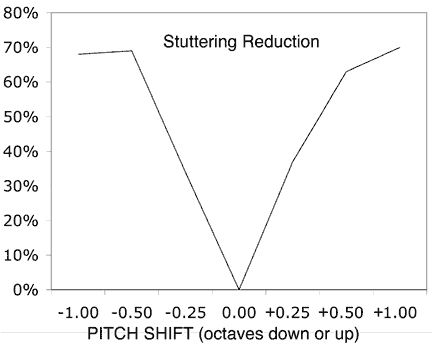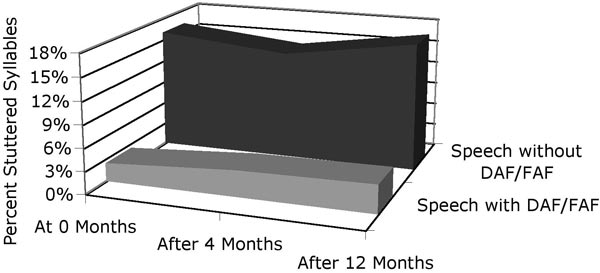Speech-Language Pathology/Stuttering/Frequency-Shifted Auditory Feedback
Frequency-shifted auditory feedback (FAF) shifts the pitch of your voice in your earphones. A FAF upshift makes you hear your voice sounding like Mickey Mouse. A FAF downshift makes you hear your voice sounding like a gravel-voiced radio announcer.
A quarter-octave pitch shift reduces stuttering about 35%. A half-octave pitch shift reduces stuttering about 65-70%. A full-octave pitch shift reduces stuttering about 70-75%.

FAF Stuttering Reduction
Shifting pitch up or down is equally effective in short-term studies. But there may be long-term differences between up- and downshifts. FAF causes non-stutterers to speak at a higher or lower vocal pitch, depending on whether the device is set for an up or down frequency shift.[1] This higher or lower pitch vocal pitch results from changing vocal fold tension. In other words, FAF induces changes in vocal fold tension in non-stutterers.
Vocal fold relaxation is a primary target of fluency shaping therapy. A study found that a half-octave FAF downshift didn't cause a change in vocal pitch in stutterers.[2] But, anecdotally, speech clinics have reported that FAF devices adjusted to one octave downshift, using newer headphones with better bass range, induce vocal fold relaxation in stutterers. A one-octave downshift has also been anecdotally reported to induce a slower speaking rate with stretched vowels. If these reports are true, then FAF downshifts appear to imemdiately induce, with little or no training or effort, the target behaviors that take weeks of fluency shaping therapy. And, if these anecdotal reports are true, then an FAF downshift should induce long-term carryover fluency.
Conversely, anecdotal reports suggest that an FAF upshift (the Mickey Mouse voice) induces vocal fold tension and faster speaking rates. If this is true, then a FAF upshift should result in poor long-term performance (e.g., no carryover fluency, and possibly "wearing off).
Types of FAF
[edit | edit source]All published studies of FAF used octave-scale FAF. Octave-scale FAF requires lots of computing power (a fast Fourier transformation). When you set these devices to a one-octave upshift, the 125-Hz fundamental frequency of an adult male voice is shifted up to 250 Hz. The 250 Hz first overtone of your voice is shifted to 500 Hz. The 500 Hz second overtone of your voice is shifted to 1000 Hz. And so on.
If you instead use a one-octave downshift, your 125 Hz voice is shifted in your earphones to 62 Hz. Your 250 Hz first overtone is shifted to 125 Hz, and so on.

Octave-Scale vs. Frequency-Compression FAF
But some FAF devices don’t have enough processing power to produce octave-scale FAF. Instead, a simpler process uses frequency compression/expansion FAF. The upshift adds 500 Hz to your voice (or 1000 Hz or 2000 Hz, depending on the setting). Thus, your 125 Hz fundamental frequency is shifted to 625 Hz, or more than two octaves up. Your 250 Hz first overtone is shifted to 750 Hz. Your 500 Hz second overtone is shifted to 1000 Hz.
When you switch frequency compression/expansion to downshift or subtract 500 Hz from your voice, your 125 Hz fundamental frequency vanishes. 125 Hz minus 500 Hz is nothing (there are no negative frequencies). The 250 Hz first overtone of your voice also vanishes. And the 500 Hz second overtone of your voice vanishes. You can only hear the weak third (1000 Hz) and higher overtones of your voice. With such a device, you may hear your voice in your ear rise in pitch as the FAF is adjusted lower!
No published studies have investigated whether frequency compression/expansion FAF has an effect on stuttering.
Long-Term Effects of DAF Combined with FAF
[edit | edit source]Nine stutterers used a DAF/FAF device about seven hours per day. Their fluency was measured after four months and after twelve months.[3] [4] The delay was set at 60 milliseconds and the frequency compression FAF at 500 Hz up. The subjects received brief speech therapy, specifically to prolong vowels and use "starter sounds" such as "um" and "ah."

Long-term effectiveness of DAF/FAF device
Compare these effects to the long-term effects of a DAF device (without FAF).
The two anti-stuttering devices had similar immediate effects. The DAF device reduced stuttered words about 70%. The DAF/FAF device reduced stuttered syllables about 80%.
Both devices show a small but statistically insignificant "wearing off" effect over time.
The difference between the two studies is the "carryover fluency," or the subjects' speech without the devices. The DAF users had more than 50% carryover fluency. The DAF/FAF users had no statistically significant carryover fluency.
Why did one anti-stuttering device produce carryover but another device didn't? Hypothetically, upward FAF has positive immediate effects but negative long-term effects. Hearing your voice shifted up (sounding like Mickey Mouse) may correct your auditory processing underactivity but make your speech motor activity worse (i.e., make you speak with a higher vocal pitch and tighter vocal folds). If the auditory processing effect goes away when the device is removed, but the speech motor changes are retained, then no carryover would result.
Another hypothesis is that using an anti-stuttering device for practice, rather than wearing it all day, may produce better long-term results.
Personal Experiences with Frequency-Shifted Auditory Feedback
[edit | edit source]Please read Speech-Language Pathology/Stuttering/How to Participate in this Wikibook before adding material to this section.
References
[edit | edit source]- ^ Elman, J. (1981). "Effects of frequency-shifted feedback on the pitch of vocal productions," Journal of the Acoustical Society of America, 70 (1). Burnett, T.A., Senner, J.E., and Larson, C.R. (1997). "Voice F0 responses to pitch-shifted auditory feedback: A preliminary study," J. Voice, 11, 202-211. Burnett, T.A., Freedland, M.B., Larson, C.R., Hain, T.C. (1998). "Voice F0 responses to manipulations in pitch feedback," Journal of the Acoustical Society of America, 103 (6) June 1998.
- ^ Natke, U., Grosser, J., & Kalveram, K.Th. (2001) Fluency, fundamental frequency, and speech rate under frequency shifted auditory feedback in stuttering and nonstuttering persons. Journal of Fluency Disorders, 26, 227-241.
- ^ Stuart, A., Kalinowski, J., Rastatter, M., Saltuklaroglu, T., Dayalu, V. "Investigations of the impact of altered auditory feedback in-the-ear devices on the speech of people who stutter: initial fitting and 4-month follow-up," International Journal of Language and Communication Disorders, 2004, 39:1, 93-113.
- ^ Stuart, A., Kalinowski, J., Saltuklaroglu, T., Guntupalli, V. "Investigations of the impact of altered auditory feedback in-the-ear devices on the speech of people who stutter: One-year follow-up," Disability and Rehabilitation, 2006. 1-9.
